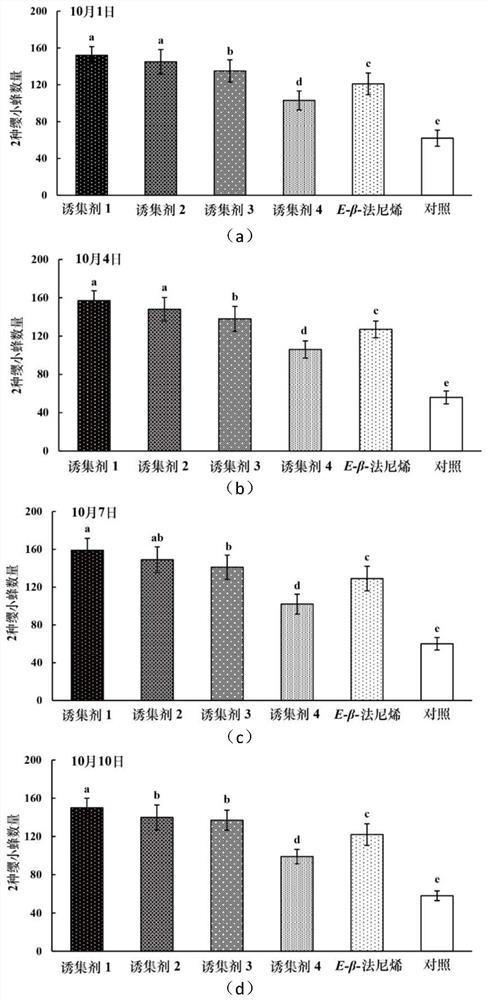Trapping agent for Stethynium empoascae Subba Rao and Schizophragma parvula Ogloblin and application thereof
A technology of the rifting wasp and wasp, which is applied in the direction of application, attracting pesticides, biocides, etc., can solve the serious occurrence of pests, limit the development of organic tea and other problems, and achieve the effect of reducing and exempting chemical control
- Summary
- Abstract
- Description
- Claims
- Application Information
AI Technical Summary
Problems solved by technology
Method used
Image
Examples
Embodiment 1
[0019] Example 1 The effect and difference of 6 kinds of alternative attractants in trapping the wasps
[0020] 1 Materials and methods
[0021] 1.1 lure preparation
[0022] Alternative attractant 1 (i.e. the attractant of Leafhopper triclads and Microrifts): each mL solution contains linalool, methyl salicylate, trans-2-hexenal, The contents of perillene and E-β-farnesene were 0.1 mg / mL, 0.2 mg / mL, 0.3 mg / mL, 5.8 mg / mL and 14.6 mg / mL, respectively, totaling 21 mg.
[0023] Alternative attractant 2: The contents of linalool, methyl salicylate, trans-2-hexenal and perillene in each mL solution were 0.32mg / mL, 0.64mg / mL, and 0.96mg / mL, respectively. mL and 18.56mg / mL, subtotal 20.48mg.
[0024] Alternative attractant 3: The contents of linalool, methyl salicylate, trans-2-hexenal and E-β-farnesene in each mL solution are 0.14mg / mL and 0.28mg / mL respectively , 0.42mg / mL and 20.44mg / mL, the subtotal is 21.28mg.
[0025] Alternative attractant 4: The contents of linalool, met...
Embodiment 2
[0047] Example 2 The effect and difference of 5 kinds of attractants in trapping 2 kinds of wasps
[0048] 1 Materials and methods
[0049] Using n-hexane as solvent, based on the ratio of linalool, methyl salicylate, trans-2-hexenal, perillene and E-β-farnesene in a ratio of 1:2:3:58:146, Prepare the following 4 attractants:
[0050] Each mL contains 0.05 mg, 0.1 mg, 0.15 mg, 2.9 mg, 7.3 mg of linalool, methyl salicylate, trans-2-hexenal, perillene and E-β-farnesene, respectively. Aggregate 1;
[0051] Attractant 2 containing 0.1 mg, 0.15 mg, 2.9 mg, and 7.3 mg of methyl salicylate, trans-2-hexenal, perillene, and E-β-farnesene per mL;
[0052] Attractant 3 containing 1 mg, 1.5 mg and 7.3 mg of methyl salicylate, trans-2-hexenal and E-β-farnesene per mL;
[0053] Each mL contains 4 mg of methyl salicylate and trans-2-hexenal, and 6 mg of attractant 4.
[0054] In addition, an attractant containing 10 mg of E-β-farnesene per mL was prepared.
[0055] Take n-hexane as CK....
Embodiment 3
[0060] Example 3 Attractant 1 (attractant for Leafhopper tricuspidus and Microrift wasp) effectively lures two kinds of wasps to control tea leafhoppers
[0061] 1 Materials and methods
[0062] The attractant 1 of preparation example 2 is loaded on wool felt, and each wool felt lure core contains linalool, methyl salicylate, trans-2-hexenal, perillene and E-β-farnese 0.1 mg, 0.2 mg, 0.3 mg, 5.8 mg, and 14.6 mg of olefin, respectively, and also contained 100 μL of n-hexane and 1.5 mg of antioxidant Butylated hydroxytoluene, and sealed with a polyvinyl chloride film. On August 17, 2020, an organic tea garden was selected in Meijiawu Village, Hangzhou City, Zhejiang Province, with an area of 4 mu and divided into two. Half of it was used as CK without any pest control measures. The other half is used as the trapping area for the small bee, and the attractant 1 lure core is placed between the tea shoots on the upper layer of the tea bushes, 10cm away from the top of the tea s...
PUM
 Login to View More
Login to View More Abstract
Description
Claims
Application Information
 Login to View More
Login to View More - R&D
- Intellectual Property
- Life Sciences
- Materials
- Tech Scout
- Unparalleled Data Quality
- Higher Quality Content
- 60% Fewer Hallucinations
Browse by: Latest US Patents, China's latest patents, Technical Efficacy Thesaurus, Application Domain, Technology Topic, Popular Technical Reports.
© 2025 PatSnap. All rights reserved.Legal|Privacy policy|Modern Slavery Act Transparency Statement|Sitemap|About US| Contact US: help@patsnap.com



